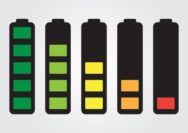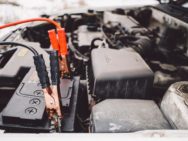
New to off-grid living? Thinking about going off-grid? Have years of experience? Bet you’ve thought about batteries.
Having a back-up store of energy for those cloudy still days, when your renewable energy system isn’t exactly on top form, is a grand idea. But navigating through the types of battery and which is most suitable can seem like a bit of a minefield. Actually, quite a huge minefield.
Way back when…
Initially when off-grid living took off, people turned to car batteries for their storage needs. However, being designed to give out a large current in a short burst, they couldn’t take the strain of being used for longer periods. This usually ended in a burnt out battery after only a year or two of use (if you were very lucky). but a few folk DID get lucky and begged or bought old Fork-lift truck batteries – and found them to be ideal.
Enter Deep-cycle Lead Acid batteries
Designed for a steady current output over long periods and with several hundred discharge- recharge cycles over its lifetime, these are perfect for partnering with renewable energy.
There are several different types of lead acid batteries which can be used off-grid. The most commonly used in conjunction with solar and wind power are: golf cart batteries, L16 batteries and industrial batteries. All of these are flooded with electrolyte which evaporates during charging, meaning maintenance is required. This extends to checking electrolyte level a minimum of once per month and topping up with distilled water when needed.
Golf cart batteries are good for those completely new to off-grid living, who have a small scale renewables system. The upfront cost of these units is low, meaning if first timers make any mistakes and ruin a battery, the financial loss is minimized. Lasting 4-5 years, these batteries have a reasonable lifespan. They are durable, and can withstand undercharging without too much impact on their storage capacity – reducing the chance you will be scratching our head and saying: “hmm this battery doesn’t seem to hold its charge as long as it used to”.

Batteries can be scaled up in a bank, depending on the amount of storage required. A set of four 6 volt, 225 amp batteries in sequence can hold 4kWh, increase this number and you could potentially have a bank capable of storing up to 16kWh. With prices starting below $100 for one unit, this is by far the most economical option for those with small scale electricity needs.
If you want to step it up from a golf cart battery, then L16 batteries may be the way to go. Even though the units are twice as heavy at 120lbs! They can power small to medium set ups and have a lifespan of up to 8 years. There are also 2 volt models available, allowing for greater storage capacity if a lower voltage is not an issue. However, these units are between 2-3 times more expensive than your standard golf cart battery, but if you have a little extra cash to spend, this could be a good option to go for.
However, if you just want one battery rather than creating your own bank with multiple units, then an industrial battery might do the trick! At a hefty 300lbs these are not meant for RVs and boats. But with a 15-20 year lifespan and the ability to have them custom made to your specifications (including storage capacity) straight from the manufacturer, this does have its positives. But also a considerably higher price tag of between $2,000-10,000 per unit, depending on specs.
If you don’t want the hassle of maintaining a flooded battery you can always opt for a sealed lead acid one.
Instead of a fluid electrolyte, these units have gel or absorbed ones. This means the only thing they need to keep in good working order is proper charging. Alongside this, no gases are produced so you don’t have to worry about appropriate ventilation. They don’t suffer from corrosion either because there is no leakage. Models of these units such as Absorbed Glass Mat (AGM) units are also easily stackable, taking up less space. However, despite all of these positives they are sensitive and can be easily overcharged. And the big whopper is they aren’t exactly a cost effective option, with prices that are double that of an industrial flooded lead acid battery, but with half the lifespan.
Alternatively, Lithium ion batteries are gaining ground, especially in light of this being the technology behind Tesla’s Powerwall.
They can deliver more discharge/recharge cycles over their lifespan (approximately 10 years), compared to lead acid batteries and can be charged at higher currents. They are lighter and take up less space also, making them easier to install and change. Due to their lightweight nature, they are also great for RVs and boats. Not only this, but when standing idle they lose only 1-3% storage capacity per month compared to up to 15% for lead acid batteries. So if you’re someone who only uses their RV or boat for vacations every few months, then this might be a better option.
However, there are some drawbacks to these types of batteries. Firstly, they need a Battery Management System (BMS) to monitor the voltage and temperature of the units. This is because even Lithium ion batteries made in the same batch can have variations in capacity. Therefore, when charging, some batteries can become full quicker than others, resulting in dangerously high voltages in some of the units. A BMS shunts the current away from full cells to still charging cells, protecting the system. It can also detect over-heating of cells and will shut off the charging pack to protect all the batteries.
Clearly, this all comes with a heftier price tag than a lead acid battery, for both the unit and associated BMS. And remember – in comparison to lead acid batteries the technology is relatively untested in terms of its longevity. Plus, Lithium ion batteries aren’t widely manufactured yet – so when it comes to replacement equipment or management systems it is not as easy to find what you need as lead acid batteries. However, when this technology becomes more widespread and the price of the units comes down, then there could well be a shift away from lead acid and towards lithium ion batteries.

And just to throw a spanner in the works…
Aquion Energy have brought out a saltwater battery. Yes you read that correctly. Instead of using lithium salts or sulphuric acid for the electrolyte fluid, the Aspen battery uses a non-hazardous sodium sulphate solution. Coming in 24 volt and 48 volt models, the 260lb units are stackable and can be discharged 100% before recharging. The units can operate between -5 and 40°C. Currently, they are being tested in a pilot project in Vermont as part of an “off-grid package”, offered by utility company Green Mountain Power.
Although this is designed for long term stationary energy storage (sorry boat and RV owners) it is aimed at those living off-grid at a supposedly competitive price. The components of the battery are made from relatively cheap, abundant materials and each unit is easy to manufacture. Therefore, an inexpensive manufacturing process should pass on savings to the consumer. Aquion Energy have been given the North American Company of the Year award from the 2017 Global Clean Tech 100, and the Aspen Battery has been named in Building Green’s Top 10 products of 2017. So if you’re fancying something a little different, Aquion’s Aspen battery might be the thing for you. You can find out more about how many batteries you would need to meet your energy requirements here.
Hopefully, you haven’t been left too bamboozled by the battery minefield.
Essentially, what is going to be best for you depends greatly upon your circumstances and budget. If your budget is low and you don’t mind a bit of maintenance, then lead acid batteries are probably your best bet. However, if you have a larger budget, but only vacation in your RV or boat, then a Lithium ion battery with low rates of self-discharge might be a good option to consider. And if you want to break the mould and don’t mind being a bit of a guinea pig, perhaps give the saltwater battery a try – at least you won’t have the worry of your bank going up in flames!
One Response
Interesting reading.